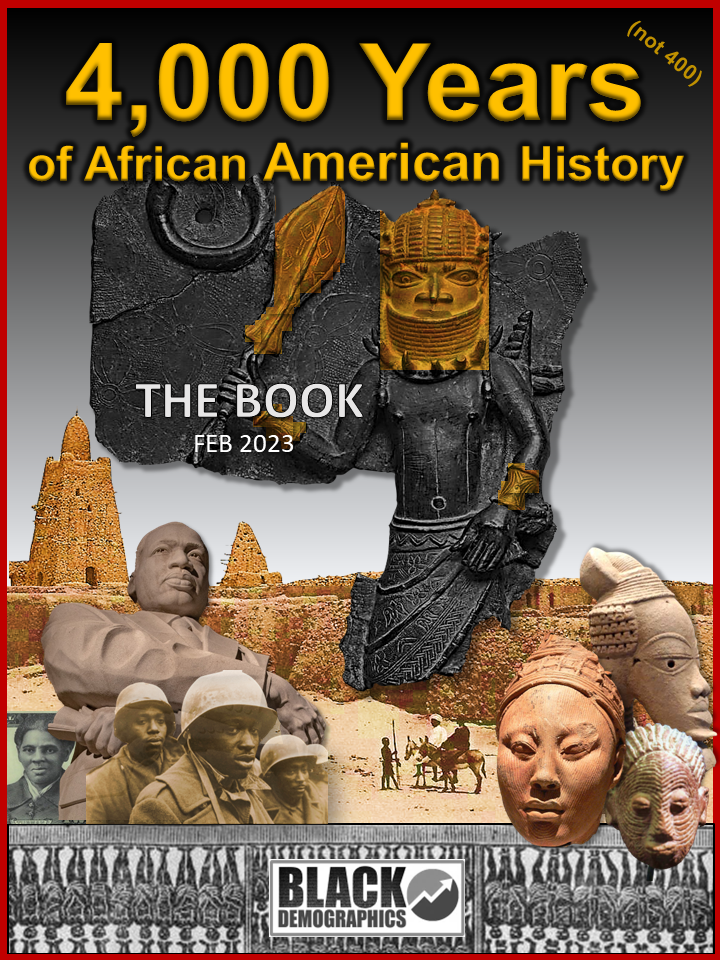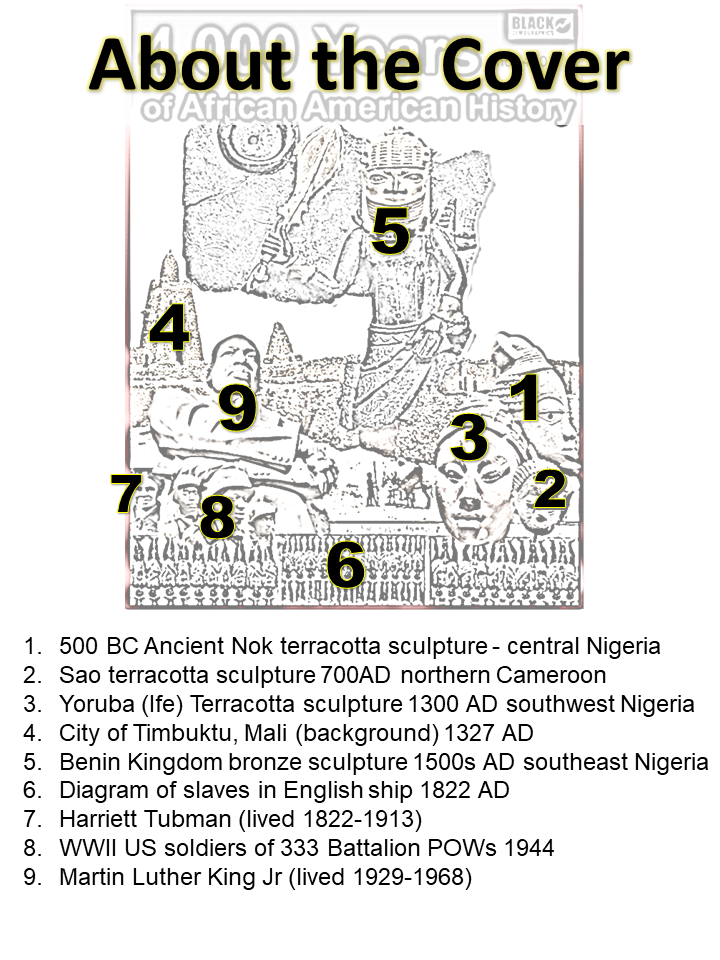Get Your Digital Copy of Our Next Big Project
Donate $12 to this project and get a free digital copy when it is complete (projected for February 2023)
All credit card transactions are also handled by PayPal. Blackdemographics.com has no access to your credit card details. We only use your name and PayPal email to send you the book when it’s ready. Scroll down for a detailed outline.
Table of Contents
4,000 Years of African American History
Introduction
- The dark continent?
- Hollywood and the classroom
- The surprising number of existing sources
Ancient Africa
- The Great Sahara Desert as a sea and its southern coast
Western African Origins
- What we will cover
PART 1: The Empires of Gold
(present-day countries of Senegal, Gambia, Mali, Ghana, Ivory Coast, Liberia, Guinea, Mauritania, Sierra Leone, and Guinea Bissau).
Tichitt and Walata (2000 BC-500 BC)
- What we know and what we don’t know
Mema (500 BC – 800 AD)
- Mande society, the first Niger Valley cities, and iron technology
- Mande traditional religion
Djenne-Jeno (250 BC – 1100 AD)
- City of Iron and blacksmiths
Ghana Empire (300 AD – 1200 AD)
- The Mande build an empire.
- Gold for salt and riches
- Mande government structure
- Islam as a balance
- Takrur: Fulani’s first Islamic West African kingdom
- An Arabs’ detailed description of Ghana
- The griots and the power of the orator
Mali Empire (1200 AD -1670 AD)
- Collapse of Ghana
- Susu conquest
- Rise of Sundiata Keita (A Lion King)
- Battle of Kirina in 1235 AD.
- The Manden Charter (a constitution)
- Mali expansion and security
- Food and industry
- Imports and Exports
- Rise of an international West African economy
- Mansa Musa
- Written first hand accounts of Mali
CITIES OF THE NIGER RIVER
-Timbuktu
- Books, Universities, and the intellectual class (like Boston)
- First hand accounts
-Djenne
- Manufacturing and trade center (like Detroit)
-Gao
- The Songhai people
- Military and Administrative center (like Wash DC)
- First hand accounts
Songhai Empire (1375 – 1591 AD)
- Decline of Mali
- Sonni Ali the Great and Terrible
- Military and naval conquests
- Askia the Great
- Infrastructure, taxes, and trade
- The Mossi
THE AKAN KINGDOMS OF THE IVORY AND GOLD COASTS
Bono Kingdom (1000 AD)
- An economy connected to Ghana, Mali and Songhai
- Akan societal structure
- Matrilineal patriarchy
- Akan royal structure
- Akan religion
- Other Akan kingdoms
Birth of Asante (1650-1701 AD)
- Legend of Osei Kofi Tutu I
PART 2: Ancient Nigeria and Lake Chad Kingdoms
(present day countries of Nigeria, Benin, Chad, northern Cameroon and eastern Niger)
ANCIENT NORTHERN NIGERIA
-What about Egypt and Nubia (The Afro-Asiatic)
- Legends, linguistics, and DNA; what we know and what we don’t
Gajiganna – Zilum (1800 BC to 400 BC)
- What we know
Sao Civilization (500 BC-1500 AD)
- Afro-Asiatic City-states
Kanem-Bornu Empire (700 AD)
- Old nomadic religion
- New Islamic kingdom
- Conquerors of Fezzan
- Trade with Ghana and Egypt
- From enslavers to enslaved
- Invaders of Sao and influencer of Hausa
Hausa Kingdoms – Kano (700 AD)
- Afro-Asiatic city-states evolve
- Part of the Mali West african trade network
- Between Songhai and Bornu
- Specialized city state economies
- Migrations in and out
- Enter the Fulani
- Southward to Yorubaland
CENTRAL AND SOUTHERN NIGERIA
Ancient Nok of Central Nigeria (1000 BC)
- Civilization of iron and terracotta
YORUBA KINGDOMS
Ile-Ife (City of the Gods) (800 AD)
- Legends and God’s
- Yoruba urban development systems
- Paved streets and courtyards
- Surplus agriculture economy
- Food production
- Glass manufacturing
- Trade within the West African economy
- Government and Royal structure
Benin Kingdom (1180 AD)
- Sons of Ile-Ife
- Edo urban development
- First hand account
Oyo Empire (1400 AD)
- Hausa, Europe, and the economy
- Oyo Government structure
- Oyo Military
- Expansion
- Sin against Ile-Ife
DEMOCRACIES OF THE IGBO
Igbo-Ukwu (850 AD)
- Archeological ties to Ife or nok
Nri Kingdom (948 AD)
- Kingdom without an army
- Theocratic but Kingless
- Igbo Religion
- Government structure and the power of the orator
- Economic, social, and gender mobility
- Freedom to choose
- Life, liberty, and pursuit of happiness.
- Igbo’s place in the West African economy
PART 3: The End of the Golden Age: Europe comes to West Africa.
The fall of Constantinople
- The scramble to get to India and China
- Pope gives power to conquer and enslave
- Portugal lands in Senegal
- Battle of Tondibi and the end of Songhai
Slavery in Western Africa
- Slavery, or servitude, or both
- What changed when European needs shifted
West African trade with Europeans
- European kingdoms fight each other for access to Africa
- African kingdoms fight each other for access to Europe
Bambara Empire (1712 AD)
- Mande traditional religion prevails
- Invasion of the Niger Valley
- First hand account
- Bambarans on slave ships
Wolof and Futa Jallon Kingdoms
- Theocracy, Jihad, and slave ships
Asante Empire (1701 AD)
- Consolation of the Akan
- End of the gold trade
- Guns for captives
- War with Everyone
The Kong Empire (1710 AD)
- Diverse Empire at war
Dahomey (1600 AD)
- War with Oyo and others
- Male king, female soldiers
- Slaves for guns
Aro Confederacy
- Democracy falls, fear prevails
- Slaves for guns, guns for slaves
Part 4: Congo-Angola Kingdoms
(present day Democratic Republic of Congo, Angola, Congo, and Gabon)
Ancient Congo Basin
- The Bantu Migration
The Kongo Kingdom (1400 AD)
- Kongo goes Christian
- King Alfonso I
- Angola a threat
- Divide and conquer
- Vita Kempa Joan of Arc
Kingdoms NDongo and Matamba (1600 AD)
- Queen Zinga
- Portuguese need more slaves
PART 5: Trans-Atlantic Slave Trade (1500 to 1820 AD)
FROM AFRICA TO NORTH AMERICA
- Senegambian Coast
- Windward Coast
- Gold Coast
- Bight of Benin
- Bight of Biafra
- Congo/ Angola
ARRIVAL IN NORTH AMERICA
Georgia/ South Carolina
- Mande, Wolof, Fulani
- Why they hate the Igbo
- The Gullah
Virginia/ Maryland
- Why they love the Igbo
Southern Louisiana
- Bambara, Yoruba, and Congo
PART 6: U.S. Domestic Slavery
1776 Slave Economy under the US Constitution
The making of an American slave
- Africa and Africans surviving in America
- Africans in the American slave economy
- Work songs, shout songs, call and response, and the orator
- The planter-class elites and the “American Dream”
Slavery Expands
- New slave states
- Cotton becomes king
- Planter-class elites create a slave confederacy
- Texas causes of secession
- BLACK CIVIL WAR SOLDIERS. Fighting for their own independence
PART 7: Emancipation and the Great Migration
Reconstruction Era 1865 until 1877
- Freedman’s Bureau
- Radical Black Republicans
- Gospel music, and the blues. The new Groits
- The new African Kingdoms: The Church 1865-1895
- Sharecropping and economic options
- Jazz: African-Americans fuse African and European classical music 1912
Black Settlements
- Mound Bayou, Mississippi 1887
- Oklahoma Black towns from 1865 to 1920
- Harlem, New York 1867-1917) and the Afro-American Realty Company
First Great Migration
- The Klansman as the new American Hero
- WWI – jobs and Black soldiers
- RED SUMMER
- Chicago
- Atlanta
New Black immigrants
- Caribbean
PART 8: The Second Great Migration 1941 to 1970
Migrating North
- After the Great Depression,
- WWII creates job opportunities and housing shortage
- Government subsidized suburban White patriarchy
- Redlined out of wealth
Moving West: Los Angeles
- Hollywood and self-identity
The Civil Rights Era
- MLK the Griot and orator
- War on Poverty
- Vietnam War and the other Opium crisis (Heroine)
- White Flight.
- Economic integration and the death of a Black owned economy.
- Government subsidized urban Black matriarchy
PART 9: The NEW Great Migration 1970 to 2000
Black Poverty
- HIP HOP: the new griots
- Crack-cocaine epidemic and war on drugs
- Welfare state, Incarceration, and the reduction of the Black Patriarch
- The “Inner-city”: get out, or get lost in it!
Growing Black Middle-Class
- Black Flight and suburban integration
- Growth of majority Black suburbs
- Back to the South and Sunbelt
After 2000
The Great Recession
- Near collapse of the Black middle class
- Gentrification comes for the “Inner-city”
- Black political power fades with population shifts.
Rise in Activism
- Black Lives Matter
- Buy Black owned
Conclusion
African America – A Powerful Nation
Donate $12 to this project and get a free digital copy when it is complete (projected for February 2023)
All credit card transactions are also handled by PayPal. Blackdemographics.com has no access to your credit card details. We only use your name and PayPal email to send you the book when it’s ready. Scroll up for a detailed outline.



